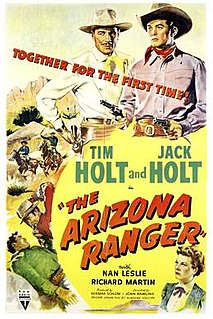
George Glenn Strange was an American actor who mostly appeared in Western films and was billed as Glenn Strange. He is best remembered for playing Frankenstein's monster in three Universal films during the 1940s and for his role as Sam Noonan, the bartender on CBS's Gunsmoke television series.

The Story of Robin Hood is a 1952 action adventure film produced by RKO-Walt Disney British Productions based on the Robin Hood legend, made in Technicolor and filmed in Buckinghamshire, England. It was written by Lawrence Edward Watkin and directed by Ken Annakin. It is the second of Disney's complete live-action films, after Treasure Island (1950), and the first of four films Annakin directed for Disney.

Tom London was an American actor who played frequently in B-Westerns. According to The Guinness Book of Movie Records, London is credited with appearing in the most films in the history of Hollywood, according to the 2001 book Film Facts, which says that the performer who played in the most films was "Tom London, who made his first of over 2,000 appearances in The Great Train Robbery, 1903. He used his birth name in films until 1924.

Tom Tyler was an American actor known for his leading roles in low-budget Western films in the silent and sound eras, and for his portrayal of superhero Captain Marvel in the 1941 serial film The Adventures of Captain Marvel. Tyler also played Kharis in 1940's The Mummy's Hand, a popular Universal Studios monster film.

Dan White was an American actor, well known for appearing in Western films and TV shows.

Riders of Destiny is a 1933 pre-Code Western musical film starring 26-year-old John Wayne as Singin' Sandy Saunders, the screen's second singing cowboy. It was the first of a series of sixteen Lone Star Westerns made for Monogram Pictures between 1933-1935, by Wayne and director Robert N. Bradbury, and the first pairing of Wayne with George "Gabby" Hayes.

William Stanley Blystone was an American film actor who made more than 500 films appearances between 1924 and 1956. He was sometimes billed as William Blystone or William Stanley.

Frank Sidney Hagney was an Australian actor. He is known for his work on It's a Wonderful Life (1946), Ride Him, Cowboy (1932) and The Sea Beast (1926).

Hit the Saddle is a 1937 "Three Mesquiteers" Western B-movie starring Bob Livingston, Ray Corrigan, Max Terhune, and Rita Hayworth, before she became famous. It was second in The Three Mesquiteers series released by Republic Pictures. The film was directed by Mack V. Wright.

Grand Canyon Trail is a 1948 American Western film starring Roy Rogers combining Western action with Three Stooges-style slapstick. Robert Livingston plays the head villain and James Finlayson plays the sheriff. The Republic Pictures film was shot in Trucolor, but only black and white prints survive.

Water Rustlers is a 1939 American Western film directed by Samuel Diege. It was the first of three Dorothy Page singing cowgirl films for Grand National Films.

Billy the Kid's Gun Justice is a 1940 American Western film directed by Sam Newfield for Producers Releasing Corporation, and 3rd in PRC's Billy the Kid series.
Phineas Fay Clanton was the son of Newman Haynes Clanton and the brother of Billy and Ike Clanton. He was witness to and possibly played a part in a number of illegal activities during his life. He moved frequently in his early life from Missouri to California and to Arizona.

Rustlers is a 1949 American Western directed by Lesley Selander. The film is a Tim Holt B Western about a group of Arizona ranchers intent on stopping a gang of cattle rustlers.
Trail Guide is a 1952 American Western film directed by Lesley Selander and starring Tim Holt. It lost $20,000.

Pistol Harvest is a 1951 Western film starring Tim Holt.
Robbers of the Range is a 1941 American Western film directed by Edward Killy and starring Tim Holt, Virginia Vale, Ray Whitley, and Emmett Lynn.

Sagebrush Law is a 1943 American Western film directed by Sam Nelson and starring Tim Holt and Cliff Edwards.

The Arizona Ranger is a 1948 American Western film directed by John Rawlins and starring Tim Holt and his father Jack.

Son of Django is a 1967 Italian Spaghetti Western film written and directed by Osvaldo Civirani.

















